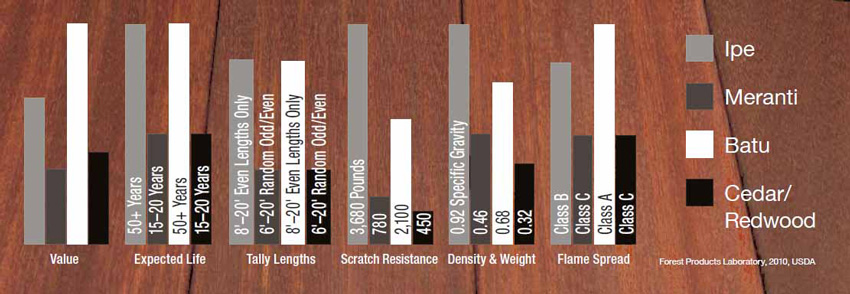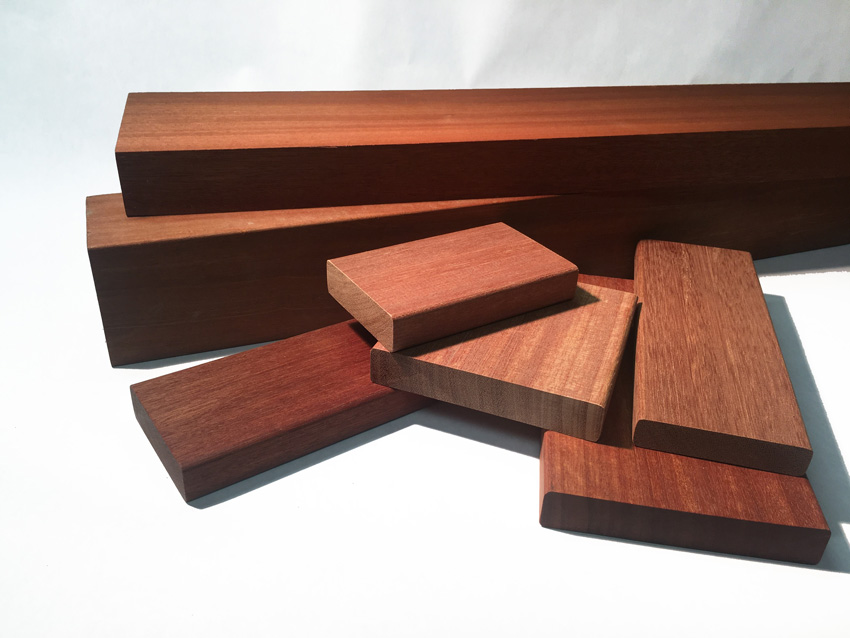Technology and Trends in Sustainable Tropical Hardwoods
Selection Criteria and Issues
You don’t need to have years of experience or a forestry degree to select and specify tropical hardwoods. However, some basic knowledge is helpful to avoid confusion. Let’s delve into more detailed information regarding specific characteristics and species of tropical hardwood.
Durability: The degree of durability can and does vary between different tropical hardwoods. Some are very durable and rot resistant, while others, even though they may be dark in color and heavy, are not rot resistant at all. One of the most popular hardwoods used for exterior decking during the 1990s and 2000s, primarily in the Northeast United States, was cambara (Erisma uncinatum). These decks tended to rot and decay within only 10 to 15 years, similar to a tight-knot cedar or redwood deck. Red meranti, another very popular species used primarily in the Northeast and Mid-Atlantic regions of the United States, is actually a mix of individual species within the shorea genus—and many of these species are not durable at all. Therefore, it is absolutely critical to specify, preferably by the complete scientific name, a durable species of tropical hardwood. Checking the supplier’s warranty against rot and decay is a prudent measure as well.

Know your options when specifying hardwoods. It is very important to compare durability, hardness, and strength, as well as fire ratings and length availability.
Appearance: Like all hardwoods and softwoods, the natural color in tropical hardwoods can vary significantly within a single species of wood. Ipe, for example, has a wide range of colors, from dark brown to olive green to deep red. When left unfinished in exterior conditions, all of these tropical hardwoods eventually become gray or silver.
Texture: The texture of some tropical hardwood species can become rough over time. This change in texture is referred to as raised grain and is common in some woods, such as cumaru. This is an especially important consideration for exterior decking, particularly if there will be people walking barefoot on the deck. Frequent pressure washing will exacerbate the problem, which can generally be mitigated by sanding after pressure washing.
Tannin bleed: In a few particular species, tannin bleed can be a major issue. With merbau, for example, tannin bleed is dark blood red—clearly not a good choice for your clients that like to dress in whites. A typical second-story deck open to the ground below will stain everything underneath the structure.
Stability and movement: When timber is initially cut, it is called unseasoned or “green” wood, meaning it has not undergone any drying treatment and contains a high moisture content (MC). Once the cut wood dries below its fiber saturation point, it begins to shrink as its MC decreases. There is a direct linear relationship between shrinkage and MC below fiber saturation. Conversely, when dry wood is exposed to rain or humidity, it will absorb moisture, and the wood will swell.
The vast majority of customer complaints are the result of wood products either taking on moisture and swelling or losing moisture and shrinking. The boards on decks built too close to the ground, without adequate spacing edge to edge or adequate ventilation on the underside of the deck, will likely cup, buckle, and warp. Most hidden fastener systems for decking do not allow for swelling of boards after installation.
Some tropical hardwoods, like massaranduba, are known for their high movement with changes in the MC, while others move much less. This is important when attaching wood to a structure since hardwood movement based on moisture changes has been measured to exert upward of 10,000 pounds per square inch of pressures. That amount of pressure has been known to push decking off its supports or even bend and shear some fasteners.
Since wood is dimensionally stable with changes in temperature, swelling and shrinkage in tropical hardwoods is therefore a direct result of changes in moisture content in the wood. Hence, all installations must have adequate spacing, fasteners that accommodate that movement, and adequate ventilation.
Checking, warping, and cupping: All tropical hardwood species will exhibit some degree of checking, cupping, and warping when allowed to fluctuate from very dry to very moist conditions. The best way to minimize this movement is to slow the flow of moisture into and out of the boards, which requires waxing end cuts and coating all sides with a high-quality finish.
Common names vs. scientific names: Understand that even though tropical hardwoods may have the same common name, they can be vastly different. Tropical hardwoods are called by many different names. Some common names like mahogany or meranti are used as a broad reference to include hundreds of different species of wood. Therefore, it is important to identify wood by the genus and species. Doing so will ensure the wood specified will have the desired characteristics.
Choosing Tropical Hardwood Species
Recognizing the above criteria, we will now look at two of the most common species of tropical hardwoods that exhibit exceptional characteristics and very minimal undesirable qualities.
Ipé from South America
This is perhaps the best-known and most publicized tropical hardwood. Ipé (pronounced ee-pay) is a very dense, non-buoyant wood with excellent durability. Dense wood is appealing because density is associated with strength and hardness. Another great quality is that it can survive for 50-plus years with very little maintenance when compared to other hardwoods. Ipé has a high tannin content, allowing it to remain very rot resistant and maintain an attractive appearance. It’s also great for decks exposed to direct sunlight because wood conducts heat slower than PVC decking, meaning that it remains cool to the touch for longer.
Is Ipé Sustainable?
Ipé clearly sounds like a great choice, but it also appears that it has become a victim of its own success. The difficulty of cutting and milling this very hard wood combined with high demand means that it comes with a comparatively high price. That high demand has also led to some concerns with sustainability due to over-harvesting. Increased harvesting has been high enough in recent years that there is speculation that it may soon be listed as a threatened species by the Convention on International Trade in Endangered Species of Wild Fauna and Flora (CITES). This is an international agreement between governments whose aim is to ensure that international trade in specimens of wild animals and plants does not threaten their survival. This pending designation has caused inconsistent availability and very high market prices. Going forward, ipé may not be a sustainable or cost-effective viable option.
Batu as an Alternative Tropical Hardwood to Ipe
Based on the discussion above, there has been a trend to use other tropical species that are more available, more sustainable, and still very appropriately suited for use as decking, siding, and other exterior applications. One of these alternative species is a tropical hardwood referred to as batu, which is emerging as a preferred and highly available choice. The name batu is the generic or local name given to red balau, which is in the Dipterocarpaceae family, the Shorea genus, and the guiso species.

Batu/red balau is an attractive tropical hardwood that is available in a wide variety of sizes and shapes.
Batu has sometimes been grouped in with “mahogany decking.” This designation is based more on its red coloring and straight grain than its natural strength and durability. For example, red meranti is a group of species, sometimes called Philippine mahogany, which is naturally found in Southeastern Asia, specifically in Malaysia, Indonesia, and the Philippines. The heartwood of meranti trees is considered only moderately durable, and it can have a much wider range of coloration than batu. Similarly, cambara is another medium-density wood sourced from South and Central America. The heartwood is typically a uniformly dull pink, pinkish brown, or golden brown. It is important to note that neither meranti nor cambara are derived from the same family of trees as genuine mahogany. Genuine mahogany (Swietenia macrophylla) is not readily available in typical decking or siding boards and is prohibitively expensive for exterior applications. Plantation mahogany, primarily grown in the island of Fiji or Honduras, is more available but lacks the strength and stability of natural forest-grown genuine mahogany. The generic grouping of batu as a mahogany has caused confusion since batu is the only durable species in this group.
The key point here is to do the research and be sure to specify a truly durable species of wood. Avoid meranti, Philippine mahogany, cambara, and plantation mahogany, and in all cases, check the supplier’s warranty against rot and decay. In this light, genuine batu is often selected as the preferable choice.
Batu Traits
Batu is currently imported into the United States by at least a half dozen different importers from forests in Indonesia and Malaysia. Most people compare it to ipé and point out several shared characteristics. Batu shares a high density and hardness but is easier to work with than ipé. It will also last 50 years or more but is a lighter-weight and more color-consistent product. It is readily available in a wide variety of sizes and is cost effective, typically being quoted at 30 percent less.
While the price alone can make batu more appealing than ipé, it also has some other desirable qualities that set it apart. Consistent color and grain are probably the most notable from a design standpoint. Its natural, reddish-brown tone can be preserved or allowed to weather to lighter tones that are all very visually appealing. In terms of durability, it is rated in the highest durability class of hardwoods with very good scratch resistance. It also achieves a Class A fire rating—the highest tested rating for tropical hardwoods. In order to address stability from moisture movement, batu is commonly kiln dried whenever it is used for a wood construction product.
Because batu is typically kiln dried and somewhat less stable than ipé, it cannot be used as a direct replacement for ipé in close-to-ground or close-to-water decking applications. A minimum of 36-inch clearance is recommended by most suppliers for 1x6 and 5⁄4x6 nominal boards, and 16 inches of clearance is required for 1x4 and 5⁄4x4 boards.
Another notable difference of batu is that it doesn’t have the same sustainability concerns of ipé. It is readily available from forests that are sustainably harvested with full chain-of-custody documentation. Note that species identification is important here since there are literally hundreds of species of wood under the Shorea genus, many of which are critically endangered. Hence, verifying that the wood is only sustainably harvested and legally verified as batu (red balau) is significant.









